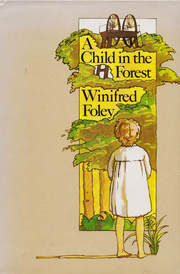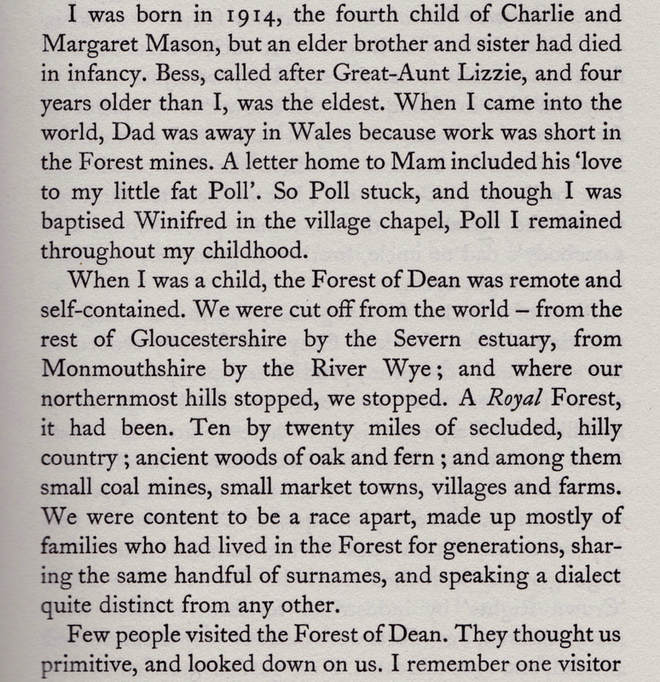I am a child in the Forest...
Upper-primary lesson ideas working with Winifred Foley's memoir A Child in the Forest
Upper-primary lesson ideas working with Winifred Foley's memoir A Child in the Forest

Please note, page numbers below refer to the 2009 paperback re-issue of the book under the title of
Full Hearts and Empty Bellies.
One of the main aims of the current English curriculum is to, “ensure that all pupils appreciate our rich and varied literary heritage.”
The following ideas have been used in a number of classes in Forest schools. Please feel free to use, adapt and extend to suit your pupils, setting and needs. Some teaching objectives have been included but they are only a small example of the possible links to the curriculum. There are many more!
Full Hearts and Empty Bellies.
One of the main aims of the current English curriculum is to, “ensure that all pupils appreciate our rich and varied literary heritage.”
The following ideas have been used in a number of classes in Forest schools. Please feel free to use, adapt and extend to suit your pupils, setting and needs. Some teaching objectives have been included but they are only a small example of the possible links to the curriculum. There are many more!
Warm up / Introduction
Pupils work in small groups to brainstorm and record ideas about the following areas:
Home: describe their house/home e.g. number of bedrooms, modern/old, favourite room and why, how do they feel at home? Is their bedroom special to them, do they have a special toy or possession?
Wood/forest: Do they live near woodland? Describe it. What activities do they take part in? – den building, cycling, walking the dog? Can they describe any flora and fauna found there?
Family: Who is in their immediate family? How would they describe them?
Weekend: What do you and your family do on the weekend/free time?
By the end of this activity you should have a large bank of words, phrases, short descriptions of what pupils see, feel and do living in the Forest of Dean. These will be used later.
Home: describe their house/home e.g. number of bedrooms, modern/old, favourite room and why, how do they feel at home? Is their bedroom special to them, do they have a special toy or possession?
Wood/forest: Do they live near woodland? Describe it. What activities do they take part in? – den building, cycling, walking the dog? Can they describe any flora and fauna found there?
Family: Who is in their immediate family? How would they describe them?
Weekend: What do you and your family do on the weekend/free time?
By the end of this activity you should have a large bank of words, phrases, short descriptions of what pupils see, feel and do living in the Forest of Dean. These will be used later.
Winifred Foley
Introduce the pupils to the writer Winifred Foley. A short biography and photographs can be found here
Pupils will use an extract from A Child in the Forest to discover what life was like for a child living in the Forest of Dean in the 1920s and 1930s.
Pupils will use an extract from A Child in the Forest to discover what life was like for a child living in the Forest of Dean in the 1920s and 1930s.
- Increasing their familiarity with a wide range of books, including myths, legends and traditional stories, modern fiction, fiction from our literary heritage, and books from other cultures and traditions (Y5/6 Reading)
What does this writing tell us about life for a child at that time?
Listen to this extract of Winifred talking to friend and author Ralph Anstis about what the village of Brierley was like (clip courtesy of Forest Community Media)
Listen to this extract of Winifred talking to friend and author Ralph Anstis about what the village of Brierley was like (clip courtesy of Forest Community Media)
Highlight/annotate copies of extract.
When she was 14yrs old, Winifred had to leave the Forest to work in ’Service’ for a wealthy family in London.
Listen to the following audio extract where she talks about leaving her Forest:
(clip courtesy of Forest Community Media)
- Checking that the text makes sense to them, discussing their understanding, and explaining the meaning of words in context
- Asking questions to improve their understanding of a text (Y3/4 Reading)
- A local history study (KS3 History)
- Read a wide range of fiction and non-fiction, including in particular whole books, short stories, poems and plays with a wide coverage of genres, historical periods, forms and authors. (KS3 Reading)
When she was 14yrs old, Winifred had to leave the Forest to work in ’Service’ for a wealthy family in London.
Listen to the following audio extract where she talks about leaving her Forest:
(clip courtesy of Forest Community Media)
Reflect/discuss what these extracts tell us about what the Forest meant to her.
Writing Task
- Organising paragraphs around a theme (Year 3/4 writing)
- Proposing changes to vocabulary, grammar and punctuation to enhance effects and clarify meaning (Year 5/6)
I am a child in the Forest of Dean.
- Family
- Home/village/woods
- Weekends
- Holidays
- How do you feel about living here?
The work can be completed over a morning in school but there are many ways that it could be extended into a week’s English work or as inspiration for art work or as a history source or even as the starting point for a local history project by:
- Using extracts and others from the book as a basis for whole class/ group reading comprehension tasks
- Use drama to support the understanding of the text
- Comparing and contrasting the description of her home and immediate village, Brierley (p6-7, chapter ‘In Our Village’), ‘We children didn’t think about whether we were isolated…’, with descriptions of the house in London (p152-3, chapter ‘In the East End’), ‘Though I had thought the road was shabby…’
- Extending the time given for planning and drafting the writing by incorporating specific writing objectives e.g. using a wide range of devices to build cohesion within and across paragraphs
- Use Winifred Foley’s or pupils' own description of the Forest as inspiration for artwork/painting
- Use the brainstormed bank of words as a starting point for poetry work
- Use Winifred’s writing as a starting point for poetry work – a poem describing life at that time
- Research their village/town in the 1920s and 1930s. Compare to now
- Investigate Forest dialect. A basic ‘dialect dictionary’ can be found online here
- Do any of their family use dialect? Can you decipher what they mean? Can you write using dialect?
- Research other Forest writers and poets e.g F W Harvey, Joyce Latham, Keith Morgan...
Resources shared here are for educational purposes, and all copyright remains with the authors. Gloucestershire County Libraries in the Forest of Dean are an excellent source of local books for loan. Please contact us if you would like help to find more local resources on this topic to support your teaching.
comments
If you have found these resources useful or have any suggestions please let us know here...



